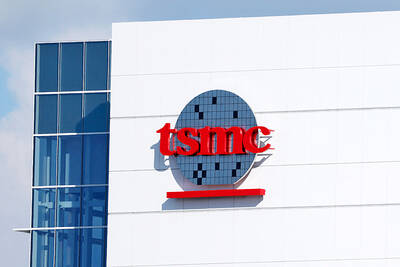Supply chain woes cost Apple Inc US$6 billion in sales during the company’s fiscal fourth quarter, which missed Wall Street expectations, and chief executive Tim Cook said that the impact is likely to be worse during the current holiday sales quarter.
Cook on Thursday said that the quarter that ended on Sept. 25 had “larger than expected supply constraints” as well as COVID-19 pandemic-related manufacturing disruptions in Southeast Asia.
While Apple had seen “significant improvement” this month in those facilities, the chip shortage has persisted and is now affecting “most of our products,” Cook said.
“We’re doing everything we can do to get more [chips] and also everything we can do operationally to make sure we’re moving just as fast as possible,” he said.
Cook said the company expects year-on-year growth for its quarter ending in December. Analysts expect growth of 7.4 percent to US$119.7 billion.
“We’re projecting very solid demand growth year-over-year, but we are also predicting that we’re going to be short of demand by larger than US$6 billion,” Cook said.
Shares of the California-based company, which had risen nearly 15 percent this year, fell 3.4 percent in extended trading on Thursday. The dip could make Microsoft Corp the world’s most valuable company after a run-up in Microsoft shares on the strength of its cloud computing business.
Apple’s results were mixed in a fiscal fourth quarter seen as a lull before the high-sales holiday end of year.
Apple said that revenues and profits for the fiscal fourth quarter were US$83.4 billion and US$1.24 per share, compared with analyst estimates of US$84.8 billion and US$1.24 per share, data from Refinitiv showed.
The results were a rocky end to a fiscal year of above-expectations sales led by its iPhone 12 models, and strong sales of Mac computers and iPads for working and learning from home during the COVID-19 pandemic.
Apple told investors in July that chip constraints would start to hit its iPhone and iPad lineups for the first time in the fourth quarter.
Apple has “managed to navigate the problems fairly well, but hasn’t escaped unscathed, and an extended duration of these problems is likely to spell trouble, especially because the market is unforgiving when it comes to Apple’s performance,” Hargreaves Lansdown equity analyst Sophie Lund-Yates said.
Apple missed expectations in two key categories.
Fourth-quarter iPhone sales were US$38.9 billion, short of estimates of US$41.5 billion, Refinitiv data showed.
Cook said that chips made with older technology remain the key supply constraint. He said that Apple remains unsure whether the shortages are to ease after the holiday shopping season.
“It’s very difficult to call,” Cook said.
The company’s accessories segment, which contains fast-growing categories like its AirPods wireless headphones, came in at US$8.8 billion, half a billion dollars lower than analyst expectations of US$9.3 billion, the data showed.
Other segments fared better. Sales for iPads and Macs were US$8.3 billion and US$9.2 billion, compared with analyst estimates of US$7.2 billion and US$9.2 billion, the data showed.
The company’s services segment — which contains its App Store business — had sales of US$18.3 billion, up 26 percent, compared with analyst expectations of US$17.6 billion. Cook said that Apple now has 745 million paid subscribers to its platform, up from 700 million a quarter ago.
“Services were strong, and it shows the beauty and durability of software and services, as there are better margins and no supply issues, since software doesn’t arrive on a container ship,” said Hal Eddins, chief economist at Apple shareholder Capital Investment Companies.
Another bright spot in the company’s results was its sales in China, up 83 percent to US$14.6 billion.

Real estate agent and property developer JSL Construction & Development Co (愛山林) led the average compensation rankings among companies listed on the Taiwan Stock Exchange (TWSE) last year, while contract chipmaker Taiwan Semiconductor Manufacturing Co (TSMC, 台積電) finished 14th. JSL Construction paid its employees total average compensation of NT$4.78 million (US$159,701), down 13.5 percent from a year earlier, but still ahead of the most profitable listed tech giants, including TSMC, TWSE data showed. Last year, the average compensation (which includes salary, overtime, bonuses and allowances) paid by TSMC rose 21.6 percent to reach about NT$3.33 million, lifting its ranking by 10 notches

Popular vape brands such as Geek Bar might get more expensive in the US — if you can find them at all. Shipments of vapes from China to the US ground to a near halt last month from a year ago, official data showed, hit by US President Donald Trump’s tariffs and a crackdown on unauthorized e-cigarettes in the world’s biggest market for smoking alternatives. That includes Geek Bar, a brand of flavored vapes that is not authorized to sell in the US, but which had been widely available due to porous import controls. One retailer, who asked not to be named, because

SEASONAL WEAKNESS: The combined revenue of the top 10 foundries fell 5.4%, but rush orders and China’s subsidies partially offset slowing demand Taiwan Semiconductor Manufacturing Co (TSMC, 台積電) further solidified its dominance in the global wafer foundry business in the first quarter of this year, remaining far ahead of its closest rival, Samsung Electronics Co, TrendForce Corp (集邦科技) said yesterday. TSMC posted US$25.52 billion in sales in the January-to-March period, down 5 percent from the previous quarter, but its market share rose from 67.1 percent the previous quarter to 67.6 percent, TrendForce said in a report. While smartphone-related wafer shipments declined in the first quarter due to seasonal factors, solid demand for artificial intelligence (AI) and high-performance computing (HPC) devices and urgent TV-related orders

MINERAL DIPLOMACY: The Chinese commerce ministry said it approved applications for the export of rare earths in a move that could help ease US-China trade tensions Chinese Vice Premier He Lifeng (何立峰) is today to meet a US delegation for talks in the UK, Beijing announced on Saturday amid a fragile truce in the trade dispute between the two powers. He is to visit the UK from yesterday to Friday at the invitation of the British government, the Chinese Ministry of Foreign Affairs said in a statement. He and US representatives are to cochair the first meeting of the US-China economic and trade consultation mechanism, it said. US President Donald Trump on Friday announced that a new round of trade talks with China would start in London beginning today,